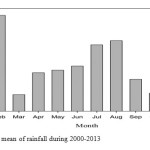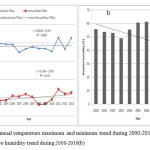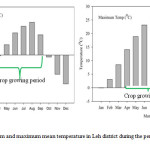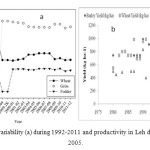Influence of Weather Variation on Cropping Pattern of Leh District of Ladakh Region
H. M. Meena1 , J. C. Tewari1 , M. S. Raghuvanshi2 , C. B. Pandey1 and Latief Ahmad3
1
ICAR-Central Arid Zone Research Institute,
Jodhpur,
Rajasthan,
342003
India
2
ICAR-CAZRI,
Regional Research Station,
Leh-Ladakh,
Jammu and Kashmir,
India
3
Sher-e- Kashmir University of Agricultural Sciences and Technology of Kashmir Shalimar,
Srinagar,
190025
Jammu and Kashmir
India
DOI: http://dx.doi.org/10.12944/CWE.10.2.13
Leh district is situated between 32-36° N latitude and 75-80° E longitude with an altitude ranging from 2500 to 6000 m above mean sea level. Leh is the largest district in the country with an area of 45,100 Km2. Agriculture is the main occupation of the rural people of the district. Initial analysis of the data revealed that the acreage of wheat crop increased from 2003 onward. Notably, a simultaneous decrease in acreage of barley crop was observed. It is noticeable that wheat crop replaced the barley crop from 2003 onwards. Such change in cropping pattern was found related with change in weather condition. It was observed that from 2003 onward monthly mean of daily minimum temperature during May increased from 4 °C to 8 °C up to 2007. Similarly, monthly mean of daily maximum temperature was observed higher (>20 °C) before 2003 but decreased during 2003 to 2009 (range 15 to 20 °C). Snowfall was a common phenomenon during month of May before 2003, but was not observed during 2003 to 2009. Therefore, it is hypothesized that increase in both minimum and maximum temperature during May had enabled the farmers to grow wheat in place of barley. Moreover, during the month of April, snowfall events were significantly reduced in 2003-2009 and in month of May snowfall events was not recorded at all. This may perhaps another reason which enabled farmers to sow the wheat crop during last week of April to mid of May. Interestingly during last two years, the cropping pattern is again reversed. The acreage under wheat crop was decreased and the acreage under barley increased. Such reversal may be due to re-occurrence of snowfall events during first two weeks of May, which was absent during 2003-2009. Therefore, it is quite apparent that weather condition influenced the cropping pattern and crop acreage. However, many other factors like timely availability of seed, quality of seeds as per need of local farmers as they prefer some straw producing varieties, crop rotation pattern, etc., also plays some role in shifting of cropping pattern. Long term data base on crop-weather relationship among with the other factors may help in developing crop weather modeling.
Copy the following to cite this article:
Meena H. M, Tewari J. C, Raghuvanshi M. S, Pandey C. B, Ahmad L. Influence of Weather Variation on Cropping Pattern of Leh District of Ladakh Region. Curr World Environ 2015;10(2) DOI:http://dx.doi.org/10.12944/CWE.10.2.13
Copy the following to cite this URL:
Meena H. M, Tewari J. C, Raghuvanshi M. S, Pandey C. B, Ahmad L. Influence of Weather Variation on Cropping Pattern of Leh District of Ladakh Region. Curr World Environ 2015;10(2). Available from: http://www.cwejournal.org/?p=11961
Download article (pdf)
Citation Manager
Publish History
Select type of program for download
| Endnote EndNote format (Mac & Win) | |
| Reference Manager Ris format (Win only) | |
| Procite Ris format (Win only) | |
| Medlars Format | |
| RefWorks Format RefWorks format (Mac & Win) | |
| BibTex Format BibTex format (Mac & Win) |
Article Publishing History
| Received: | 2015-06-15 |
|---|---|
| Accepted: | 2015-07-15 |
Introduction
Leh is the largest district in the country with an area of 45,100 Km2. Agriculture is the prominent occupation of the rural folk of the district. Naked barley, locally known as ‘grim’ is the major food grain crop of the district. Wheat, pulse, oil seeds and other millets are also grown in scattered areas. Whole of the cultivated area is irrigated and the source of irrigation water is mainly streams originated from glaciers. Both diurnal and seasonal variation of temperature is very high with a range of temperature from 35°C during summer and -35°C during winter season. Annual average rainfall of Leh is 100 mm, which mainly occurs during May-September. Snowfall during winter (November to March) is a common weather phenomena and therefore only one crop can be grown throughout the year. According to crop calendar of Leh district, barley is sown during mid of May and wheat crop is sown during last week of April to 2nd week of May.
The cold desert region of India is characterized by harsh climatic condition i.e. dry and cold weather, heavy snowfall, low temperature, which sometimes on an average goes down to as low as -35oC in late nights. Some time in summer months, on an average temperature reaches to as high as +35oC in after noon (Kapadia 1996). Analysis of meteorological data for last 35 years indicated that there was rising trend of minimum temperature at Leh nearly 1oC for the winter months and 0.5oC for summer months (Singh and Dwivedi 2011). They have also indicated that the present horticultural zone in lower valleys could shift in some cases over hundreds of kilometers in higher cool and mountainous areas. In contrast, the already warm areas climate change can cause reduced productivity. Apricot cultivation is not affected much by climate change although there may be a shift in flowering time and maturity period. Snowfall during bloom adversely affects apricot production and productivity. Sea buckthorn plant is able to tolerate moisture as well as temperature stress (-30oC) (Singh, 2008. In potato maximum harvest index of 0.8 is obtained at the night temperature of 15oC and it becomes zero at 28oC. Increase in night temperature would increase its area in high altitudes above 12000 feet, improve productivity and total yield (Singh 1995). For sustainable crop production in the region, there is need to develop technologies especially, in the context of climate change. Research efforts were made by SKUAST-K and State agriculture departments to improve the crop production in the region but limited efforts were done to formulate alternate cropping pattern under weather change condition.
Materials and Methods
Weather and acreage data collection
Weather data of Leh district were collected for 2000-2013 from High Mountain Arid Agriculture Research Institute (HMAARI) SKUAST-K, and KVK, and State statistical department, Leh-Ladakh, J&K. These weather data are mainly of temperature (°C) (minimum and maximum), relative humidity RH (%), and precipitation (mm). Hourly weather data for 2012 also collected from IMD AWS installed at Leh and these data are comprised of all weather parameters. Data on crop acreage of Leh district during 1991-2000 was downloaded from http://leh.nic.in/dept.htm and during 2000-2012 were collected from statistical department and (HMAARI) SKUAST-K, Leh. Data on crop productivity of Leh district for 1980 to 2007 was also downloaded from http://www.cmie.com’ with the help of CRIDA computer cell at Hyderabad.
Analysis of data set
Analysis of weather data and acreage data were carried out in MS excel, 2007 and simple trend analysis to find out the trends of weather and acreage data. After that crop acreage and weather parameter were correlated.
Result and Discussion
Precipitation
Annual rainfall of Leh district is less than 100 mm and mostly occurs in form of snow. From the point of view of crop establishment, April and May month is very important because according to crop calendar of Leh district, barley is sown during mid of May and wheat crop is sown during last week of April to 2nd week of May. In the month of April in 2004 and 2005 occurrence of snowfall was recorded however, after 2005 rainfall occurrence was observed upto 2009 and in the year of 2010 both were recorded (Table 1). In the month of May, Snowfall was recorded in 2010; however from 2003 to 2009 there was no snowfall in this month (Table 1). Monthly mean of precipitation variability of Leh during 2000-2013 (Fig.1). In general, rainfall occurred during crop growing period (April-Sept) is too meagre (Ahmad and Kanth, 2014).
 |
Figure 1: Monthly mean of rainfall during 2000-2013 Click here to View figure |
Table 1: Monthly mean of precipitation (mm) (R-rainfall and S-snowfall) during 2004-2010
|
Month |
2004 |
2005 |
2006 |
2007 |
2008 |
2009 |
2010 |
|
Jan |
55 (S) |
58 (S) |
29 (S) |
- |
211(S) |
66(S) |
15( S) |
|
Feb |
5 (S) |
135.5 (S) |
115 (S) |
4.1 (S) |
25 (S) |
20 (S) |
70 (S) |
|
Mar |
48 (S) |
16.5 (S) |
- |
0.4 (S) |
NIL |
5 (S) |
11 (S) |
|
Apr |
1 (S) |
87 (S) |
24 (R) |
- |
6.6 (R) |
NIL |
88 (S)/41.1 (R) |
|
May |
0.5 (R) |
0.4 (R) |
- |
- |
8.7 (R) |
NIL |
67 (S)/19.6 (R) |
|
June |
9.5 (R) |
2.7(R) |
- |
5.2(R) |
0.9(R) |
4.4 (R) |
35.5(R ) |
|
Jul |
- |
28 (R) |
- |
11.4(R) |
10.3(R) |
3 (R) |
2.5(R) |
|
Aug |
7(R) |
- |
78 (R) |
- |
23.9(R) |
5.5 (R) |
58.4(R ) |
|
Sept |
6.5 (R) |
- |
50 (R) |
- |
23.5(R) |
10 (R) |
12.5(R ) |
|
Oct |
25 (R) |
- |
- |
- |
Nil |
4 (R) |
9 (S) |
|
Nov |
- |
- |
3 (S) |
- |
Nil |
190 (S) |
Nil |
|
Dec |
- |
- |
61.5 (S) |
- |
10 (S) |
30 (S) |
97(S) |
Source:- Defence Institute of High Altitude Research, C/o 56 APO
Relative humidity
Initial analysis of the data revealed that mean relative humidity (%) is highest at Leh in the month of February (55.6 %) and December (55.3%). It was also observed that the relative humidity prevailed low during crop growing period as compared to other periods. During the last decade, decreasing trend of relative humidity was observed (Fig.2b).
 |
|
Temperature
It is most important weather parameter in cold arid region for sustaining, agriculture and livestock from livelihood point of view. July was observed as the hottest month with mean maximum temperature reaching up to 28.9 °C. January was observed as the freezing month with mean minimum temperature reaching up to -15.39 °C. Monthly mean of maximum temperature varied from -0.8 °C to 26.9 °C during the year, while ranged from 14.07 °C to 26.9 °C during the crop growing period (Fig.3). In case of minimum mean temperature, it was also varied from -14.5 °C to 13.6 °C and in crop growing season it ranged from -0.3 °C to 13.6 °C. During the winter season range of mean minimum temperature was - 1.5 to -12.9 °C. Minimum temperature was observed above freezing point only 5 months (May to September) during 2000-2013, it indicates crop growing period is only of 5 months for the whole year (Fig.3). Trend of the 14 years annual mean temperature data (maximum and minimum) indicated that global warming has a significant effect in the regional climate of Leh (Fig.2a).
 |
Figure 3: Monthly minimum and maximum mean temperature in Leh district during the period (2000-2013) Click here to View figure |
Crop acreage and production
Initial analysis of the data revealed that the acreage of wheat crop increased from 1991 to 1997. Notably, a simultaneous decrease in acreage of barley crop was observed. Subsequently the acreage of wheat crop decreased from 1997 to 2002 and area under barley was increased. However, crop acreage of wheat crop again increased from 2003 to 2007 and a simultaneous decrease in acreage of barley was observed. (Fig.4a), such change in cropping pattern was found related with change in weather condition. It was found that from 2003 onwards monthly mean of daily minimum temperature during May increased from 4-8 °C up to 2007. Similarly, monthly mean of daily maximum temperature was observed higher (>20 °C) before 2003 but decreased during 2003 to 2009 (range 15 to 20 °C). The trend indicated that in response to climate change primarily the shifting of onset of monsoon; farmers are preferring wheat crop in place of barley. However, during 2007-2009, the cropping pattern is again reversed. The acreage under wheat crop was decreased whether as the acreage under barley crop was increased. Analysis of data revealed that the yield of rapeseed and mustard was low during 1980-90, but during 2000-05 is high as compared to wheat and barley yield. Wheat and barley yield was observed as constant (888 and 868 kg ha-1, respectively) during 2000-2005 (Fig.4b).
 |
Figure 4: Crop acreage variability (a) during 1992-2011 and productivity in Leh district (b) during1980-2005. Click here to View figure |
Conclusion
Therefore, it is hypothesized that increase in both minimum and maximum temperature during May had enabled the farmers to grow wheat in place of barley. Moreover, during the month of April, snowfall events were reduced from 2003 to 2009 and during the month of May snowfall events was not recorded at all. Therefore, farmers were able to sow the wheat crop during last week of May to mid of April. However, during last two years, the cropping pattern is again reversed. The acreage under wheat crop was decreased and the acreage under barley crop was increased. Such reversal is may be due to re-occurrence of snowfall events during first two weeks of May, which was absent during 2003-2009. Therefore, it inferred that weather condition greatly influence the cropping pattern and crop acreage, and indirectly the crop production of Leh district. There is need to develop suitable crop-weather model for the Leh region for sustainable crop production.
Acknowledgment
We express our sincere thanks to Dr. M.M. Roy, former Director and Dr. R.K. Bhatt, present Director Incharge of ICAR-CAZRI, Jodhpur for providing continuous encouragement, necessary facilities and support to carry out the present work. Our sincere thanks are also extended to Associate Director Research, High Mountain Arid Agriculture Research Institute, SKUAST-K and KVK Leh for providing weather data.
References
- Kapadia, H. Spiti: Adventures in the TransHimalaya, Indus Publishing Company, New Delhi, India (1996).
- Singh, B. and Dwivedi, S. K. Climate change in cold arid region: Horticulture to Horti-business (2011).
- Singh, B. Vegetable Production in Ladakh. Field Research Laboratory, C/o 56 APO (1995).
- Singh, B. Sea buckthorn - A potential crop for cold arid region. In recent Initiatives in Horticulture. Horticulture society of India, New Delhi (728), 400p (2008).
- Ahmad, L and Kanth, R.H. Characterization of climate of Leh district of cold-arid Himalaya Journal of Agrometeorology, 16(2): 214-215 (2014).






